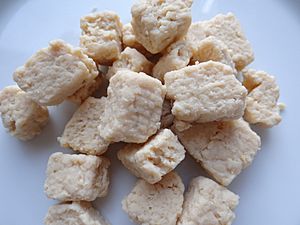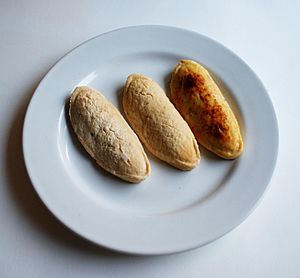Quorn facts for kids
 |
|

Quorn cordon bleu product
|
|
| Private | |
| Industry | Food |
| Founded | 1985 |
| Founder | Marlow Foods Ltd (JV between RHM & ICI) |
| Headquarters | Stokesley, North Yorkshire, |
|
Area served
|
Global |
| Products | Meat alternatives |
| Owner | Monde Nissin Corporation (2015–present) |
Quorn is a popular brand of meat substitute products. It started in the UK and is mostly sold in Europe. You can also find Quorn in 11 other countries around the world. The company that owns Quorn is called Monde Nissin.
Quorn products are sold in different ways. You can buy them as ingredients for cooking, like mince or pieces. They are also used in many prepackaged meals, such as burgers and sausages.
All Quorn products are suitable for vegetarians. This means they do not contain any meat. However, not all Quorn products are suitable for vegans. Vegan products do not contain any animal products at all.
The main ingredient in Quorn is something called mycoprotein. This special ingredient comes from a type of fungus called Fusarium venenatum. For most Quorn products, the fungus is dried and mixed with egg white. The egg white helps to bind it together. Then, it is shaped into different forms, like burgers or mince. For vegan Quorn products, potato protein is used instead of egg white as the binder.
Contents
The Story of Quorn
Quorn was first launched in 1985. It was created by a company called Marlow Foods. Marlow Foods was a partnership between two big companies: Rank Hovis McDougall (RHM) and Imperial Chemical Industries (ICI).
How Quorn Was Developed
In the 1960s, people thought there might be a shortage of protein-rich foods in the future. Scientists started looking for new ways to produce protein. They explored making protein from tiny living things like fungi.
The fungus used in Quorn, Fusarium venenatum, was found in a soil sample in 1967. After many years of testing, RHM was allowed to sell mycoprotein for people to eat in 1985. This was a big step for the food industry.
The process to make Quorn involves growing the fungus in large tanks. This method was developed with help from ICI's experience in making protein for animal feed. They used a special 40 m3 (1,400 cu ft) tank to grow the fungus.
Quorn's Journey to Stores
The brand name Quorn came from a trademark owned by RHM. This name was inspired by the Quorn Hunt, which was named after the village of Quorn in England.
Quorn products first became available in stores across the UK in 1993. After that, they were introduced to other parts of Europe in the 1990s. Quorn then came to North America in 2002. Since June 2010, you can also find Quorn in Australia.
How Quorn Is Advertised
When Quorn first started, its advertisements featured famous sports stars. These included footballer Ryan Giggs and Olympic runner Sally Gunnell. In 2013, the company chose Mo Farah, a famous runner, to be their ambassador. This was part of a plan to encourage people to be fit and healthy.
Quorn Products You Can Buy
Quorn is sold in many forms that are easy to cook. You can buy it as cubes or as a form that looks like minced meat. Over time, the company added more products. These included chilled vegetarian meals like pizzas, lasagne, and cottage pie. They also made products that look like sliced meat, hot dogs, and burgers.
By 2005, Quorn was very popular in the UK. It made up about 60% of the meat-replacement food market there. By 2006, Quorn was available in many countries. These included the UK, Belgium, Denmark, Ireland, Netherlands, Sweden, Switzerland, Canada, and the United States.
Quorn has also worked with big fast-food chains. In 2004, McDonald's offered a Quorn-branded burger. This burger had the approval of the Vegetarian Society. However, by 2009, Quorn burgers were no longer available at McDonald's in the UK.
In 2011, Quorn Foods launched a vegan burger in the United States. This burger used potato protein instead of egg white. By 2020, many Quorn items were available in the United States, including many vegan and gluten-free options.
Interestingly, most people who buy Quorn are actually meat eaters, not vegetarians. This shows that many people are looking for ways to eat less meat.
| Nutritional value per 100 g (3.5 oz) | |
|---|---|
| Energy | 384 kJ (92 kcal) |
|
2.3 g
|
|
| Sugars | 0.1 g |
| Dietary fibre | 7.5 g |
|
1.7 g
|
|
| Saturated | 0.5 g |
|
Protein
|
13 g
|
| Tryptophan | 0.18 g |
| Threonine | 0.61 g |
| Isoleucine | 0.57 g |
| Leucine | 0.95 g |
| Lysine | 0.91 g |
| Methionine | 0.23 g |
| Phenylalanine | 0.54 g |
| Valine | 0.60 g |
| Histidine | 0.39 g |
| Minerals | Quantity
%DV†
|
| Sodium |
9%
140 mg |
|
sources: mycoprotein.org quorn.co.uk
|
|
| †Percentages estimated using US recommendations for adults. | |
How Quorn Is Made
Quorn is made from a special soil mould called Fusarium venenatum. This fungus is grown in large, clean tanks filled with oxygenated water. They add Glucose (a type of sugar) and other nutrients to feed the fungus. Vitamins and minerals are also added to make the product more nutritious.
After the fungus grows, the mycoprotein is taken out. It is then heated to remove extra RNA. This step is important because too much RNA can cause health problems like gout in humans.
The mycoprotein is then dried and mixed with egg albumen. This acts as a binder, holding everything together. Then, it is shaped and textured to look and feel like meat. It can be made into mince, chicken-like pieces, meatballs, or even turkey roasts.
The final Quorn product is high in protein and dietary fibre. It is also low in saturated fat. Quorn is considered safe for babies over nine months old in small amounts. However, it's important to check the salt content, as it can vary between products.
Making Quorn has a much smaller carbon footprint than producing beef. This means it's better for the environment. Quorn for the UK and Europe is made in Stokesley, North Yorkshire, and Billingham in Stockton-on-Tees.
Quorn's Vegan Options
In late 2011, Quorn released its first vegan product, the Quorn Vegan Burger. It was first sold only in the United States. Because it sold well and there was a growing demand in the UK, Quorn started making more vegan products for the UK market. They also reduced their use of eggs overall.
In October 2015, Quorn launched a range of eight vegan products in the UK. These new products were very popular.
In January 2019, Quorn created the filling for a vegan sausage roll for the UK bakery chain Greggs. This product was so popular that it often sold out. It helped Greggs to increase its profits. In January 2020, Greggs also released a Quorn-based vegan "steak bake."
See also
 In Spanish: Quorn para niños
In Spanish: Quorn para niños



